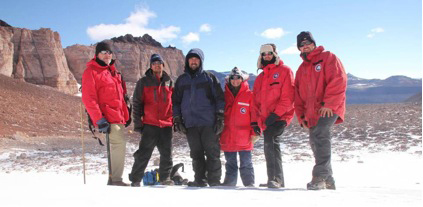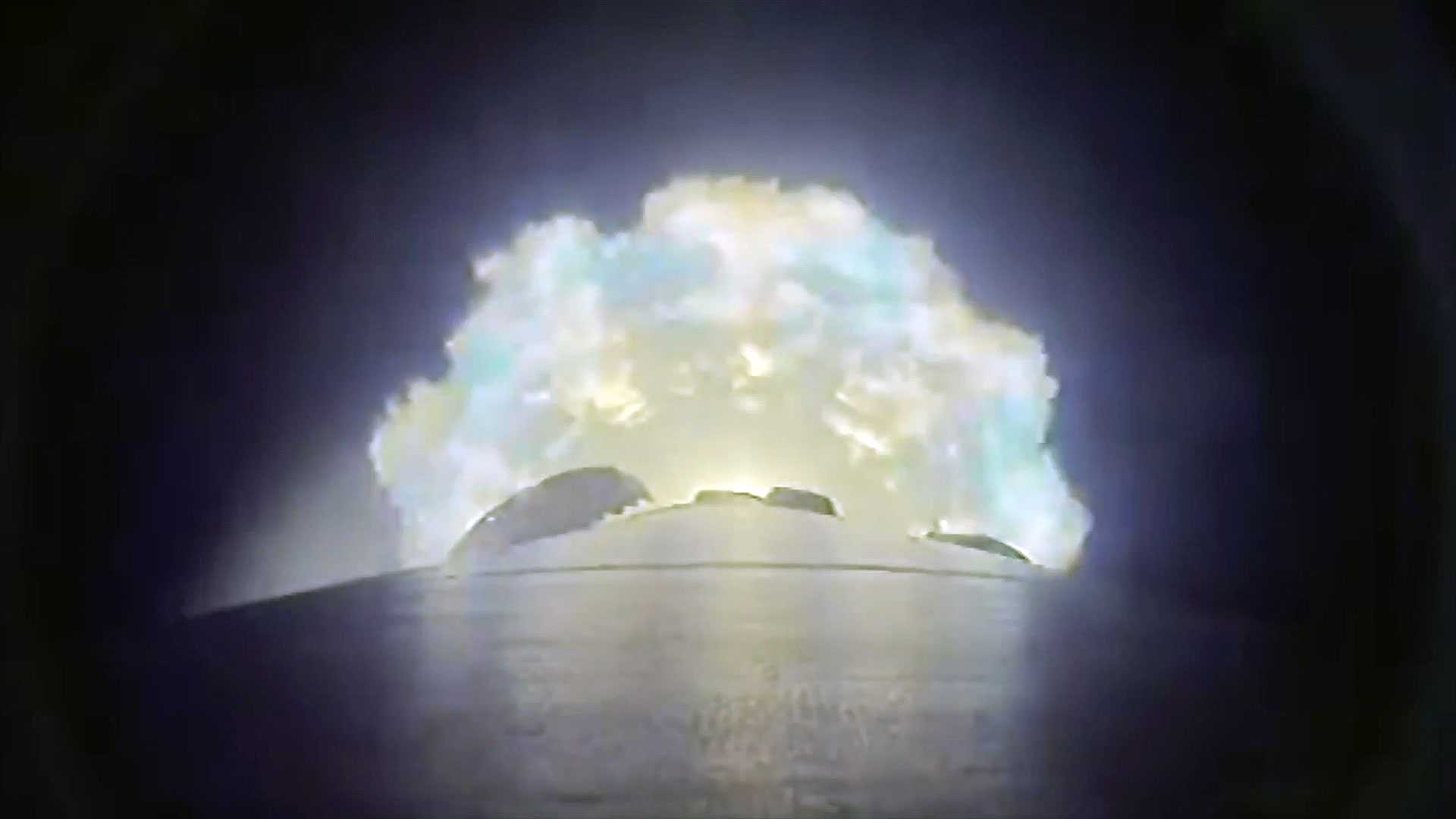Field Report: Astrobiologists Drill Into Antarctic Ice

This is mylast blog. I'm writing it somewhere over the Antarctic inside a C17airplane onour way from McMurdo Station to Christchurch, New Zealand. A C17 is averyimpressive airplane. We are sitting along the fuselage facing each other, withcargo in the middle. AC130 airplane propeller is right in front of me ? within my arms'reach. To theleft, I see our bags we dropped off last night, and to the right, somepeoplesleeping on the floor. Only now do I realize that the Antarcticadventure iscoming to a close.
Our drillteam traveled to the Antarctic to test a new generation of arotary-percussivedrill, called the IceBreaker.The drill was designed as a prototype for a drill that one day will flyto Marsand penetrate at least 1 meter into Martian ice and permafrost.
We selectedUniversity Valley within Antarctica's Dry Valleys region as an idealMarsanalog and drilling test location for two reasons: (1) temperatures arerelatively low, reaching -25 degrees Celsius during the time we stayedthere(beginning of summer); and (2) University Valley has a desiccated layeroverlaying ice-cemented ground towards the valley's mouth and massiveicetowards the valley's head. NASA'sPhoenix mission in 2008 landed in the northern polar regionof Mars andfound ice below a few inches of sandy soil ? almost exactly what we seeinUniversity Valley.
Our goal wasto drill at least 1 meter into ice-cemented ground and another meterinto ice.In both cases, we had to acquire samples at 10 cm intervals. Thisprobablyseems like a simple task, but there is a catch. All the drilling actionhad tobe performed autonomously, no human intervention was allowed. Since2004 wehave been operating the Rock Abrasion Tools (RATs) on the MarsExplorationRovers, Spirit and Opportunity, and thus have learned the extent ofautonomythat robotic systems can have. We duplicated this kind of autonomy whendesigning the IceBreakerdrill. The drill has only three commands: Seek (it finds theground), Drill(it performs drilling action), Pull Out (pulls out of the hole anddepositssample into a cup). Although these seem like simple commands, behindeach oneof them hides an algorithm that analyzes drilling telemetry and makesdecisionson how to proceed further.
Our firsttask was to assemble the drill in the field. Our system was broken downintosmall subsections that included a drill base, a vertical stage (whichhad neverbeen tested prior to this field campaign), the drill head, an augerwith a bitat the end, a sampling system (which had also never been tested), andelectronics. We rushed to meet the shipping deadline for Antarctic andhencedidn't have time to test some of its components. TheAntarctic would be the true testing ground.
All the drillcomponents were secured inside robust pelican cases and transportedinside asling (a net suspended under a helicopter) from McMurdo to the DryValleys. Toassemble the drill, we had to pull all these items out and put themtogether,just like Lego blocks. Once the drill was put together, Gale Paulsen,Honeybeesystem engineer and the IceBreaker operator, went inside a warm tent,while Istayed behind to watch the drill in action and to take lots of picturesandmovies. For the next few hours, Gale and I were not allowed tocommunicate. Galewas on Earth (inside the tent), while I was on Mars (outside and nextto thedrill).
The weatherwas perfect: very cold, with surface temperatures reaching -25 degreesCelsius(-13 degrees Fahrenheit) and subsurface temperature at around -20degrees C (-4 degrees F).Fortunately for me, we had no wind.
Breaking space news, the latest updates on rocket launches, skywatching events and more!
Gale musthave pushed the Seek button, because all of the sudden I saw the drillslowlyrotating and moving down. After a few minutes, the drill touched theground,moved up an inch and stopped. So far all went well. Next, the drillstarted torotate faster and moved down at higher speed. Soon the drill bittouched thesurface and started to cut into the overlying desiccated layer beforehittingrock-hard ice-cemented ground. After reaching 10 cm (4 inches), thedrill movedup and deposited cuttings into a small bag. I took the bag, put itaside, andattached a new one in its place. Our next drill upgrade would be toreplacethis human action of swapping bags with a robotic system (then I couldalso sitinside a warm tent).
The drillwent down again, but this time to a depth of 20 cm (8 inches), and cameupdepositing more samples. This process continued until we reach ourtarget of 1meter (40 inches). During this drilling process, our power was lessthan 100Watts (that's as much as a light bulb needs), the force of the bitpushingagainst the ground was less than 100 Newtons (around 20 lbs), and ittookaround 1 hour to reach 1 meter. We call it drilling with 1-1-100-100 (1hour to1m with 100 W and 100 N).
At the sametime we measured a temperature at the bit, to make sure we didn't heatit uptoo much. A warm bit will indicate that we are putting too much heatinto theformation, which may cause the ice within the soil or rock to melt. Wewant toavoid melting by all means, since thaw followed by re-freeze is themain causeof stuck drill bits in the Antarctic and other cold regions. Ourmaximum bittemperature was always less than -5 degrees C (23 degrees F) and onaverage itwas more like -10 degrees C (14 degrees F), that is, only 10 degrees Cabovethe ground temperature and 10 degrees C below melting temperature. Weweredrilling in a safe regime.
With thisdemonstration, we have shown that drilling on Mars (and also on themoon, in regionsthat contain water-ice, for example) is possible. The power, energy andpreloadare all within the payload capability of a small lander.
Since westill had lots of time, we decided to drill another two holes. Wevarieddrilling procedures and tested other sampling methods and protocols.All workedgreat and we collected more samples. The goal was just one hole, and wedrilledthree. We decided to call it a day and prepare the drill for a 600 feettraverse across the boulder field towards the glacier: Our next stopwasmassive ice.
The followingday, ourIceBreaker team moved parts of the drill into the new site ?in the middleof a boulder field. There was massive ice below. Assembling the drillproved tobe quite challenging. Our gloves were bulky and we had to use barehands tolift and screw parts together. After one minute exposed to cold air andtouching very cold metal, our fingers would go numb. We would have towarm themup inside gloves for a few minutes before continuing. We realized howlucky wehad been the first time, when assembling the drill inside a tent.
Drilling inice proved to be relatively easy, as expected. We drilled to 1 meter inno timeand collected samples. Upon close inspection of ice-chips, as they werecomingup the drill auger, we noticed that some of these ice chips are aslarge as 0.6cm (0.25 inch). That meant that our drilling approach doesn'tcompletelydestroy the ice. We can still acquire large ice chunks for eithervisual orother investigations.
It was onlyaround lunchtime, so we decided to carry on drilling until we reached2.5 meters(100 inches). The day was cold, and we were very cold. I looked at Galeandcould see that he was thinking what I was thinking. Well, we came todrill 1meter and we drilled to a depth of 2.5 meters. It proves that theIceBreakerdrill is capable of going way deeper than required 1 meter. We decidedto callit a day.
We movedseparate bags of ice chips into a container. These will be transportedinside afreezer from the Antarctic and all the way to NASA Ames for analysis.
We reviewedall our goals. Our first goal was to show remote operation of the drilland wedemonstrated it in McMurdo when a number of 5th graders operated adrill fromCalifornia. We then had to drill autonomously to 1 meter in icecementedvolcanic tephra (a lunar analog). We did that outside of McMurdo, whichlies ona slope of an active volcano, Mt Erebus. We also had to drill to 1meter andcollect samples of ice-cemented ground and we drilled not one but threeholes.And finally, instead of drilling a 1 meter hole in massive ice, wedrilled a2.5 meter hole. All our goals were achieved and we decided to pack upour drillfor shipping back home to Pasadena, Calif.
Our nextfield trip will be in the Arctic in 2011, but we will be back here inDryValleys in 2012. Till then!
- Gallery:Phoenix on Mars!
- Meetthe Icebite Team Members
- Photos:Scientists at the End of the World
